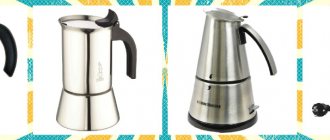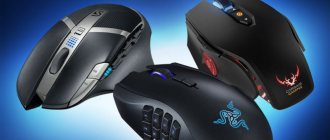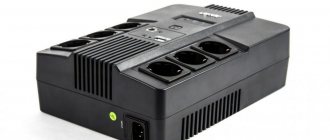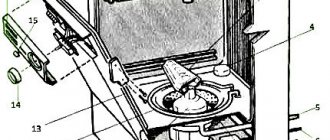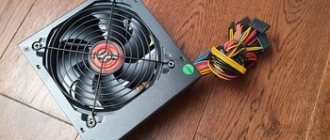What we pay for - optional intro
When you buy a product, what do you pay attention to first? That's right, first on packaging, then on content and only then on price. In the computer world, the opposite is true, and practically no attention is paid to the packaging of components (i.e., the case).
Usually, when a person wants to buy a computer, the case is in the very last position on the list of components, except perhaps before the mouse and keyboard. Here the following logic is most often followed: “first, the most powerful video card, then a processor with at least 4 cores, 6 GB of memory, and for the rest, some simple case.” Those. Usually normal people are willing to pay for the content, not the wrapper. In part, this position is correct, but here the wrapper is not just a beautiful candy wrapper, the case is a guarantor of the safety, stability and comfortable operation of the entire computer hardware.
A banal life example
Recently I witnessed how a friend of mine saved money on an “iron Felix” - a body. He took a more expensive video card, a faster processor, a lot of memory, and decided to pack it all into a cheap (noname) case. What do you think happened? That's right, trouble came from under the table: strange burning smells, melting of conductors, overheating of the CPU and other “saved” bonuses began to appear.
Therefore, in order not to throw money away, you need to plan your computer budget wisely and approach the purchase of the “packaging box” of your components – the case – wisely. We'll talk about the latter later.
Dust protection
Installing water cooling does not replace the use of dust filters. Dust, which accumulates static electrical charges and reduces cooling efficiency, remains one of the main causes of damage to processors and motherboards. Manufacturers of high-quality cases install dust filters in the front panel (complete with an exhaust fan), in the tray of the system unit and in other places in the unit.
How to choose a case and what to focus on
So, first of all, it’s worth saying that there are no norms, canons or ideals in hull building. Therefore, you shouldn’t be fooled by bright phrases – the best, ultra-modern, etc., all this is heresy. If we look at the technical side, you need to keep in mind (keep in mind when purchasing) that the following parameters exist:
- Case type (form factor, size);
- Material;
- Cooling system (coolers/fans);
- Structural elements, fastening;
- Appearance, design, gadgets.
Let's go through and analyze each parameter separately, but first, let's determine in person the main structural compartments/departments of almost any case. Actually, having removed the cover of your system unit, you can find a lot of dust inside the following niches for installing computer elements (see image).
So, the standard is:
- Place under (1). In modern models it is often located at the bottom;
- Compartments for installing flexible drives (2). A rarity for many cases;
- Cavity for installing the motherboard (3);
- Processor niche with cooling system (4);
- Connector for installing a video card (5);
- Peripheral connectors (mouse, keyboard, sound, hubs, etc.).
Now let's move directly to the parameters.
Housing design
Structurally, the body consists of:
- racks on which most components are mounted;
- frame with suspended platforms;
- removable side walls (provide access to the inside of the PC for maintenance and repair);
- rear wall (exhaust fan deflectors, ports for connecting to a monitor and keyboard are located on it);
- front panel with power and reset buttons, regulators, slots and connectors for external storage media, a device for using disks.
Additional space inside the case may be required to install a processor with a radiator and its own fan, additional hard drives, and video cards.
The general classification of types of enclosures (including closed, open, bench) is not important for practical choice. Open and bench system units are used in PC development and testing. For office, household, and gaming computers, all manufacturers primarily use closed system units.
Type of shell
The modern computer case market is represented by many models, but there are certain standards in accordance with which they are produced. These standards are embedded in the so-called form factors, which ultimately determine the size of the computer case.
The following standard housing sizes exist:
- Mini-ITX;
- Micro-ATX;
- ATX;
- EATX;
- XL-ATX;
You can also find the following classification of buildings (tower, as they are called):
- SFF (Small Form Factor) – micro;
- Mini Tower – mini;
- Middle Tower - average;
- Big Tower - big;
The difference between case standards lies in the different size range of motherboards designed for a given case. To estimate the dimensions, it is convenient to use the table (see image).
The visual size range is clearly demonstrated by the following image.
I think there is no need to say that the main criterion for choosing the type of case depends entirely on the tasks that you set for your computer brother. Those. mini and micro ATX are ideal options for unassuming office users, for whom their iron friend should simply fit well into the interior (without taking up much space), and, if possible, do the “hard” work in the form of “open-close-save” a document and other office fun :).
Case types and sizes
Computer cases are divided into horizontal (Desktop) and vertical (Tower). But both of them can have different sizes.
6.1. Horizontal enclosures
Horizontal cases were previously used mainly in offices to save space and monitors were installed directly on them.
Now such cases can be found in some supermarkets, but they are mainly used for assembling multimedia centers that can be located in a TV stand.
Horizontal enclosures have the following types:
- Slim-Desktop - thin body
- Full-Desktop - standard case
6.2. Vertical enclosures
To assemble modern computers, mostly vertical cases are used. Usually they are installed on a special stand or simply on the floor.
Vertical enclosures have the following types:
- Micro-Tower - miniature case
- Mini-Tower - low case of an outdated format
- Midi-Tower - the most common format
- Full-Tower - a large case for gaming computers
- Super-Tower - a very large case for powerful computers and servers
For office and home computers, it is better to use the most versatile Midi-Tower cases. For powerful gaming computers that install large video cards and coolers, it is advisable to use more spacious Midi-Tower or Full-Tower cases. The placement of components and ventilation are better organized in them.
What to start from
If your goal is a moderately solid and productive unit, then ATX is just what the doctor ordered. Well, the most trump card option for those who like to be more nimble is an XL-ATX standard case (aka Full Tower). As I already said, the main criterion for choosing one type of case or another depends on the “metrics” of the motherboard that you want to place there to perform the corresponding tasks. Also, the size of the case directly affects the quality of cooling inside, and therefore the lifespan and performance of all components.
Note:
- Mini-ITX are the smallest, usually come with a built-in low-power power supply (up to 350 W) and are designed for inch-sized boards.
- Micro-ATX is a typical representative of desktop solutions for home users. It has slightly more intelligible dimensions and also often comes with a built-in power supply with a power of 400-500 W. In general, it allows you to build quite satisfactory software on your site.
- ATX - often sold without a built-in power supply and gives the user complete freedom of expansion.
- EATX and XL-ATX are an excellent, high-performance (including server and powerful gaming) solution for connecting several graphics subsystems and computing cores.
Let's move on to the “material” component of the case.
Which computer case is better?
The housing is selected individually for each system. However, it is possible to create some averaged universal model for a home or gaming computer:
- Good airflow;
- The transparent side window must be made of tempered glass;
- Metal not thinner than 0.55 mm;
- Removable hard drive cages with vibration dampers;
- Bottom location of the power supply.
All other characteristics (color, form factor, presence or absence of backlighting, orientation - you can, for example, purchase a horizontal PC case) depend on the buyer.
Housing material
It would seem that it makes no difference what the case is made of, not paper, but oh well. But no, the material is important, because it must provide not only high-quality cooling, but also a certain degree of protection from mechanical damage and vibration. Most often, the body material of premium models (with a price of 8 thousand rubles) is a metal such as aluminum.
It is he (not counting copper) that has a good ability to dissipate large amounts of heat. You shouldn’t think that if the material is not aluminum, then the case will not cope well with its tasks, not at all. Most models in the mid-price (mass consumer) segment are made from special SECC steel - steel coated with a galvanic zinc solution.
An important point when purchasing will also be the build quality and the thickness of the case walls themselves. Regarding the first, it should be said that you should not buy (what seems at first glance) all-metal cheap Chinese cases. Most often, the so-called noname models are made from low-quality stamping, and the build quality leaves much to be desired, i.e. There are various backlashes, vibrations and gaps due to the fact that the housing components are not tightly fitted to each other.
Note: It is not entirely correct to think that the entire body is solid metal; you can often find plastic elements in the design of various panels, clamps, and fasteners - this is normal.
Wall thickness is also a significant parameter. If it is less than 0.5 mm, then most often it is not worth paying attention to such a case, because at the slightest vibration the rumble will be such that no earplugs will help. Therefore, try to choose the thickness of the case walls from 0.5 to 1 mm.
Lian Li TU150 Mini ITX - the best Mini ITX case of 2020
A real gaming suitcase! If you have always dreamed of having a powerful gaming PC the size of a small suitcase, and at an attractive price, then this is definitely your choice. For $109, we are offered an excellent compact case made of brushed aluminum and tempered glass. Its only problem is the inability to install standard ATX power supplies. The case allows you to install only SFX / SFX-L power supplies.
Worthy competitors
According to TechSpot, the most successful competitors of Lian Li are models from NZXT.
NZXT H210i
NZXT H1
If the first model is a more traditional version of the case, albeit small in size, then the second model from NZXT looks truly extraordinary. It is also worth noting that this case already comes with a pre-installed 650-watt power supply, which, of course, affected the price of this model. If the first model would cost you $109, then this case has a price tag of $350.
Cooling system or “Carlson” in the case
Of course, the case is not only a protector from damage, but also a ventilation casing for all components of your PC, providing the necessary “coolness” to its hot elements. However, the rule “the more wind blowers in the building, the better” does not work here. It all depends on the competent organization of the ventilation process (air circulation) by installing coolers in the right locations.
In other words, 4-5 factory fans are not always a guarantee of high-quality cooling of computer internals, because ventilation is created not by the number of “turntables”, but by air flows. And if the latter intertwine, collide and interfere with each other, then there is no effective process for removing hot air.
The conventionally common ventilation scheme for housings is the following (see image).
In this scheme, one or several large “slow” fans are installed at the entrance, drawing in fresh room air. At the outlet (the rear wall of the case) there is a slightly smaller but more “fast” fan that works for blowing out.
This design allows you to create decent thrust in a closed space and the body begins to work like a large cooling turbine, i.e. cold air, drawn through all the hot components, cools them and is thrown out.
Attaching the walls to the frame
For side and rear walls, manufacturers primarily use traditional screw fastening. Manufacturers of high-quality cases include anti-vibration washers and screws for attaching the motherboard and coolers.
Easier access for maintenance will be provided by fastenings with plastic clips, metal latches, and magnets. But such fastenings increase the cost of the case. Experienced computer scientists who often open the case (for cleaning, replacing, testing parts) tend to choose a system unit casing with such fasteners or a hinged hinged side panel. For a beginner, such an increase in the price of the case is excessive.
About the knobs separately and how to choose a body based on them
This standard design is often supplemented with “twisters” at the top and side walls of the housing, which also work for injection. In general, to create a high-quality cooling environment inside the case, you must follow the following simple rules:
- More twists does not mean better;
- The air flow must be integral and unidirectional, without being broken up by various additional flows;
- Hot air always rises up, and cold air goes down, so you should not place the vertical block on its side;
- Loose cables in the housing can disrupt the movement of air masses;
- Large cooler blades are better than small ones, because... create more air flow at fewer revolutions.
It is also worth paying special attention to the fans themselves, or more precisely, to the volume of air that they can “pump” into the case per unit of time (minute). This technical parameter is called CFM (cubic feet per minute). The volume of circulating air inside the housing must be constantly updated. And to calculate based on the dimensions of the case what kind of fan it needs, you need to resort to simple mathematics:
- Multiply the parameters (length, height, width) of the case in mm and find out its area;
- Determine the CFM of the fan.
Let's say for a case with dimensions 253x502x563 mm, the volume is 2.52 cubic meters. ft. To refresh the air every two seconds, you need to set the fan to 70 CFM. Very often inside the case you can find large air vents in the form of tubes on the side surface for cooling the processor (see image).
So, the benefits of them are rather doubtful, but they introduce their “interference” into the harmony of the air flow, because block the natural circulation of air, and in exactly the same way as unsheathed wires do. It is also worth mentioning a not particularly necessary component of the case ventilation system – dust nets.
Their effectiveness is extremely low, because literally after 2-3 months of active use of the computer, they simply become clogged with room dust, and this again interferes with normal air circulation and contributes to overheating of the computer components. In general, such pipes are rarely really effective.
By the way, we talked about how to properly deal with dust inside the system unit in our article called [3 in 1 “Large cases” or “Cleaning the dust” or “What is what in the computer”], so read and do not create dust 
TOP 10 best computer cases according to owner reviews
It is quite difficult to make a clear choice in favor of a particular model. This is due to the variety of options available in the market. But experienced players have chosen the best cases, which will allow them to opt for a proven model.
3Cott Paladin IV w/o PSU Black
Affordable PC gaming case with a glossy front panel for an eye-catching look. The red light is visible through it. At the bottom of the front panel there is a small hole for a fan. There is a lid at the top that reliably protects from dust. It is easily removable, allowing access to components. Control elements and ports for connecting devices are located on the top.
A casing is installed inside to protect the power supply, cables, and hard drives. A small amount of air is supplied inside, which reduces heat dissipation. This is due to the presence of the front panel. To improve this indicator, additional fans are installed at the top.
3Cott Paladin IV w/o PSU
- Low cost.
- Convenient location of holes.
- Sufficient number of connectors for connecting devices.
- Mounting the SSD on the case.
- Two coolers in the front and two on top; instead of the latter, you can install water cooling.
- Thin metal and side PVC insert (not glass).
AeroCool CyberX Advance Black
This case is made of 0.6 mm thick steel, which ensures high-quality heat dissipation and low weight. There is a window on the side wall and an opening sash in front. During operation, the red backlight turns on. For ease of installation of equipment, both side walls are removed.
Cooling can be represented not only by fans, but also by a liquid system. Inside you can install ATX, MicroATX, Mini-ITX motherboards vertically. Expansion boards must have a length of 330 mm, one of the seven must be 240 mm. The power supply is suitable for a length of 200 mm.
AeroCool CyberX Advance Black
- Availability of 3 coolers included.
- Original design.
- Slight noise during operation.
- The card reader is installed in the case.
- Sufficient rigidity of the frame.
- The side acrylic panel is susceptible to scratches.
Zalman N3 Black
The case has 3 120 x 120 fans, and there are two more seats to improve heat dissipation. The built-in coolers have a white backlight consisting of 15 LEDs that do not burn out for many years. The side panel is made translucent, which adds aesthetics to the model. The top cover contains controls and connectors for connecting various devices.
The internal space is organized in accordance with modern equipment, which ensures its convenient placement. Here you can install a 360 mm long video card, two 5.25″ devices, five 2.5″ drives, or two 3.5″ hard drives.
Zalman N3
- Laconic unusual design.
- Reobas for 5 coolers.
- Dust filters.
- High legs, which prevents the power supply from overheating.
- Easy to assemble.
- Very bright backlight, which is distracting when the lights are off.
Deepcool Matrexx 55 Black
An excellent case for a gaming computer with a well-thought-out cooling system. Built-in fans of 4 pieces can be supplemented with two more to improve heat dissipation. The case is quite heavy, which is due to the use of 0.6 mm thick metal and the installation of coolers.
To improve the appearance, it is possible to expand the RGB backlight. The LED strip in the front is controlled via the motherboard or manually. Easy cleaning of the dust filter is ensured by installing it on magnets.
Deepcool Matrexx 55 Black
- Glass panels enhance aesthetics.
- The presence of rubber inserts under the bolts, which prevents the glass from bursting.
- Fixed hard drive cage for quick replacement.
- High-quality fastening of the front panel using latches.
- Cable management.
- It is inconvenient to fix the cooler at the bottom of the front wall due to the basket.
Thermaltake Suppressor F1
The case has compact dimensions, two removable walls, one pre-installed 200 x 200 fan. Additionally, you can install 2 80 x 80 coolers or replace them with a liquid cooling system. Made of steel, characterized by low weight and good wall thickness.
Mini-ITX motherboards are installed inside. The upper zone is designed for effective cooling, and the lower zone is for installing the power supply, routing cables, and placing 2.5 and 3.5-inch devices.
Thermaltake Suppressor F1
- High-quality ventilation thanks to the mesh front wall.
- Ease of installation of components.
- Rubber pads on the legs prevent them from slipping or scratching the surface.
- Possibility of installing any modern video card.
- Quiet operation.
- Risk of breaking the plastic fasteners on the front panel.
COUGAR MX330-G
The kit comes with one 120 x 120 fan; you can additionally install four more of the same size. The gaming case is made of 0.5 mm steel walls, one of which has a glass insert. There is a backlight underneath it.
You can install several 350 mm video cards inside. You can also install two 2.5" and two 3.5" HDDs. The system unit can also be equipped with water cooling. Dust filters are installed on the front, top and bottom panels.
COUGAR MX330-G
- Attractive appearance, use of tempered glass.
- Front panel ports.
- Silent operation of the built-in cooler.
- High-quality ventilation.
- Tight fit of the walls, no backlash.
- Bright LED backlight.
GameMax StarLight
This is a modern gaming PC case with an unusual design. It is made of metal and acrylic, which are durable and have the ability to effectively remove heat. Removable side walls do not interfere with the installation of components. 4 fans 120 x 120 are installed as standard; in addition, you can install 2 more of the same size. It is also possible to equip it with a liquid cooling system. The coolers are equipped with LED lighting.
Dust filters capture even small particles, which does not impair heat dissipation efficiency. Inside you can install two hard drives measuring 2.5 and 3.5 inches.
GameMax StarLight
- Convenient and compact size.
- Attractive in the dark thanks to backlighting.
- Quiet operation.
- Installing the power supply from below.
- Possibility of adjusting the cooler rotation speed.
- The walls are easily scratched.
Fractal Design Focus G
The stylish gaming case is available in white or black and has a well-arranged internal space, which allows you to place components in the optimal way. Coolers are the main elements of heat dissipation. Additionally, you can equip your PC with a water cooling system. Dust filters are installed at the front, top and bottom, which prevents dust from penetrating inside and settling on components, slowing down cooling. Neatness inside the unit is achieved through a well-thought-out cable management system.
The side wall has a large window behind which LED lighting is visible. The front panel has ports for connecting various devices - headphones, microphone, electronic media.
Fractal Design Focus G
- Simplicity and ease of assembly.
- Compact external dimensions, enough internal space to install components.
- The wires can be hidden behind the back wall.
- Strength of steel 0.6 mm thick.
- Quick removal system for hard drives.
- The transparent insert is made of acrylic, not glass.
Cooler Master MasterBox Q300P
This is a bright and stylish model that can accommodate even large components. At the same time, all components are installed and connected quite conveniently due to the large dimensions of the case. Operation and maintenance are extremely simple.
The original appearance is due to the presence of purple backlight, which is visible from almost any angle. The side panel is installed not plastic, but glass, resistant to damage. As a standard, 3 120 x 120 fans are installed; additionally, you can install the same number of devices and install a liquid cooling system.
Cooler Master MasterBox Q300P
- Tinted plexiglass as a side wall.
- Rubberized pads on the arms and legs provide comfort, prevent slipping, and prevent scratching the surface.
- High quality dust filters.
- Cooler control unit.
- Thick steel side walls.
- Noise when coolers operate.
NZXT H500
Non-backlit gaming PC case. Two 120 x 120 fans are installed as standard, and to improve heat dissipation, two additional 140 x 140 fans can be installed. It is also possible to install a liquid cooling system.
The appearance of the block is very attractive, which is due to the use of a glass panel. The main part of the body is made of steel, which ensures durability. Cable management allows you to conveniently re-equip the system unit, which does not require much time.
NZXT H500
- Efficient cooling.
- Modern stylish design.
- Minimum amount of noise and vibration during operation.
- Possibility of installing the power supply with the fan down or up.
- No backlight.
- There is no adjustment of the speed of rotation of the cooler blades.
Fastening: tongue and screw. Case ergonomics
It would seem that what the screws have to do with it, but that’s what it has to do with it. Very often, in cheap cases, everything is fastened in the old fashioned way with the help of assorted screws, the replacement of which turns into dancing with a tambourine. I unscrewed 5 things, while I was screwing 3, the fourth rolled away, and one was completely lost in the dark depths of the case, I went to look for it (I took a flashlight) and along the way got scratched on the steel edges of the panels, how do you like this prospect?
Manufacturers of high-end cases have long solved such problems by using a system of plastic rivets and fasteners, as well as installing sleds for hard drives that slide out on wheels. Everything is flexible, movable and convenient (see image).
Such things (plugs, additional fasteners, clips, shelves) have a positive effect on the ergonomics of the case or, in other words, its functional “convenience” for the user. Those. ergonomics, if you like, is the expandability of your body, its ability to easily transform during modernization, including changing its external and internal appearance.
Routing cables inside the case is also an important aspect of ergonomics, because how easily they can be hidden also determines the cooling inside the case. On the other hand, the wires should always be within walking distance if you need to connect a new drive or disk, and not cause the user to experience a tug-of-war syndrome. This is when the wire does not reach the device socket, but we still pull it there, because... There are no more options.
Appearance, design and bells and whistles
What user doesn't like to show off his body? Yes, one that doesn’t have this case :). We are all human and we all want to surprise someone with something. For some computer users, this “surprising” feature is the design of the case. Here's an example (see image).
It is worth understanding that design is a purely individual thing, many are ready to sacrifice functionality for the sake of various flashing lights, backlights and nozzles, and this is a personal matter for everyone. However, do not forget that a case in strict colors with a minimum number of lights, sensors and other tinsel will always look stylish and elegant.
Among the necessary design gadgets, it should be noted that there are various types of connectors on the front (or top) panel of the case. By default, the following are always displayed: headphones/microphone and USB. Those who clearly don’t have enough of this “gentleman’s set” can easily take a case with a “spare”, which has an eSATA port for connecting a portable hard drive, a cooler rotation speed controller and a couple of modern ultra-fast USB 3.0 ports (see image).
Phew, it seems like we’re done with the practical-theoretical part, now let’s summarize in order to assimilate all the material presented as well as possible and learn how to choose the right PC case the first time.
System case design
The design of the case depends on your preferences. If you need a school computer or a work office PC, you can choose a simple gray or black plastic front panel. For a computer that works with a multimedia center or home theater, choose cases with an expressive design, with bright edges, shiny doors, lighting, and glass walls.
By the way, glass walls not only give the computer an original look, but also allow you to control the accumulation of dust inside the case. Behind the hinged front cover there can be cooler regulators and connectors for connecting external devices.
Case manufacturers most often use futuristic design for expensive gaming computers.
On the Internet, gamers order cases in the form of a spaceship, a racing car, or a medieval castle (depending on the player’s profile). The design uses colored water cooling fluids and fan lighting. The main thing is that external effects do not affect the functionality of the PC.
Frequently asked questions and frequently answered questions by choice
So, remember the following tips, and such an event as buying the right case will become a habitual activity for you :).
- Decide on the tasks that your PC will solve (office, gaming, etc.);
- Based on the tasks, select the required dimensions of the motherboard and the case for it;
- The material of the housing walls should be from 0.5 to 1 mm thick;
- Do not purchase non-name models, take a closer look at the professionals in their field: Cooler Master, Zalman, Inwin;
- A cooling system of 3-4 fans is quite enough for effective heat removal;
- Do not skimp on the block, it must have significant power, otherwise your filling will sooner or later be covered with a copper basin;
- The best location of the power supply in the case is at the bottom;
- Make sure there are plastic elements for installing the hard drive and drives;
- Try to buy a body that is free of various screws and tongues;
- Pay attention to the presence of additional connectors on the front panel of the case;
- Remember, a high-quality case begins its “price offer” from an amount of 6,000 rubles.
These tips will help you make the right choice!
In a nutshell, something like this.
Top PC case manufacturers
For your information! There are many manufacturers of computer cases. Top brands are presented below:
- Fractal Design. Swedish brand of computer components, including PC cases. The equipment of this company stands out for its maximum noiselessness and attention to detail. Cases from Fractal Design will decorate any room, as they are made in a laconic and strict design.
- NZXT. An American brand that produces efficient cooling systems and high-quality computer cases. The company uses the most advanced solutions in the production of devices. NZXT branded cases will provide comfort and pleasure when using and upgrading them.
- Corsair. An American company producing gaming components and peripherals. Corsair equipment is renowned for its quality and thoughtful design. PC cases also feature stylish designs with eye-catching RGB lighting.
- Be quiet! A German brand that produces quiet, almost silent platforms. The company's products also stand out for their ultra-technological solutions. PC cases Be quiet! — ideal in terms of price/quality ratio.
- Cooler Master. Taiwanese brand with a worldwide reputation. Specializes in the production of cases, power supplies, cooling systems and gaming peripherals. Cooler Master computer cases feature an original design and advanced ideas in terms of component placement.
- DeepCool. Chinese company producing computer components. Its products are famous for their good quality at very affordable prices. Computer cases from DeepCool also feature thoughtful design and modern design.
Where is the best place to buy a case?
First of all, we recommend three stores with approximately equal degrees of quality:
- GearBest is for those who are not afraid to buy abroad and save money. There are many interesting SSDs of the “Chinese” type, several popular brands, and in general a pleasant store where there are constant promotions and so on;
- JUST is perhaps the best choice in terms of price-quality ratio of SSDs (and not only). The prices are quite reasonable, although the range is not always ideal in terms of variety. The key advantage is the guarantee, which really allows you to change the product within 14 days without any questions, and in case of warranty problems, the store will take your side and help solve any problems. The author of the site has been using it for at least 10 years (since the time when they were part of Ultra Electoronics), which he advises you to do;
- OLDI is one of the oldest stores on the market; the company has been around for about 20 years. Decent selection, average prices and one of the most convenient sites. Overall a pleasure to work with.
The choice, traditionally, is yours. Of course, no one has canceled all sorts of Yandex.Markets, but of the good stores I would recommend these, and not some MVideo and other large networks (which are often not only expensive, but defective in terms of quality of service, warranty work etc.).
Hard drive bays
Another important point is mounting hard drives . When operating, HDDs vibrate and make noise, which in simple “boxes” turns into an annoying hum. In good cases, hard drives are separated from structural elements by vibration-isolating rubber gaskets and washers. Also, a good case can accommodate a large number of hard drives. They, of course, can be connected and left hanging, but in this case, they will not receive proper airflow. And this will shorten their service life. All these advantages are embodied in the Zalman Z11 Plus HF1 .
If you are planning to initially assemble a computer that will include 1-2 hard drives, then we recommend that you familiarize yourself with the results of our HDD testing, according to which we identify the best representatives of the “XXL” format.
- Accessories
Test of giant hard drives: big, fast and not too expensive


